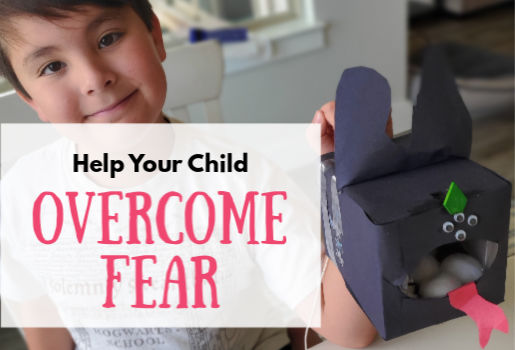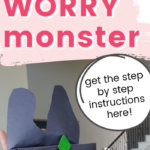The world feels like a really scary place right now and as much as we try to protect our children, they are also sensing the chaos and fear. It is important to give our children tools and resources to manage their fear.
This article will give you some specific coping skills that you can teach and practice with your children. I am also going to go over a 4 step plan for Managing Fear. Plus, I have TWO fun craft printable activities at the end that will create a visual reminder for your children to use and practice the skills you teach them.
Being afraid is a normal response to scary times
It is important to understand that fear is a very normal response to these times. Fear is also a normal response to many everyday situations such as learning to sleep alone in the dark, confronting a large dog that is barking, or worrying about bad guys getting into the house.
Many children struggle with these common childhood fears. As a parent, you can choose to shame or trick them out of their fears – which does occasionally work. Or, you can teach them how to respond to fear so that they learn to move through their fears.
Really, fear in and of itself isn’t a problem.
It is our response to fear. Children (and adults alike) can often get stuck when they feel afraid. For example, a child struggling with nighttime fear may have a hard time sleeping and get stuck in a pattern of dreading and fighting bedtime.
Falling into these fear patterns can have a downward spiral effect where every time something triggers the fear it begins to feel bigger and scarier.
4 Step Plan to Help Your Child Manage Fear
The good news about this unique time in history is that we have the chance to really teach our kids how to handle fear which can translate to any other fears they may end up having throughout their lives. Here are 4 steps that will help you teach your child to manage their fear.
Step 1: Understanding the “what if” thoughts
I find it is helpful to talk about “what if” thoughts with kids. These are thoughts that start with “what if” and quickly grow into bigger, scarier fearful thoughts.
So, for example, you may have a scratchy throat and think “what if I have Corona Virus?” Then your thoughts may start to spiral towards, “what if I get really sick?” Then, “What if I have to go to the hospital?” And ultimately, “what if I die and leave my family behind?”
While these what if type of thought spirals are really pretty normal, they can quickly overwhelm your mind and body with paralyzing fear.
To teach your child about what if thinking, use an example of something that they are worried about. For example, maybe they are worried that there might be monsters under their bed.
Once you have identified the fear, ask them, what do you think might happen if there are monsters under your bed? And once they answer ask what they think might happen then?
Doing this will help you point out the idea of “what if” thinking and show how it can grow into bigger, scarier thoughts.
Step 2: Learning that worries growing into bigger fears can overwhelm your brain with fear
The second step in teaching your child not to be scared, or to overcome their fears, is to help them understand what happens to their minds and bodies when they have those what if thoughts.
It is also important for kids to learn how one “what if” thought can lead to bigger, scary, out of control thoughts. A great visual activity to help kids learn to understand how their what if thoughts can take over their entire thought process is this simple color experiment.
What If Thought Experiment
1: Fill a clear glass or bowl with water.
2: Use a food dye dropper to drop one drop of dye into the glass. Explain that this represents their first what if thought.
3: Help your child observe how that drop starts to color and spread throughout the water.
4: Next, add a second drop/what if thought. Talk about how worries can quickly spread – just like the color – and quickly start to take over your whole brain.
5: Add a third drop. Discuss how the color/what if thoughts can really start to take over. Ask your child if they could get some clear water (or a clear thought) out of the glass at this point?
Step 3: Learning to recognize fearful thinking when it starts
The best way to teach your child to manage their fear is to help them learn to recognize that first what if thought.
It is helpful to talk about physical reactions to fear. Helping your child understand and recognize the feeling of fear in their body will help them stop their fear from getting out of control.
I also have a more detailed body map exercise in the Brave Guide to Being Afraid along with lots of other great activities to help your child learn to recognize and understand their fear and overcome being afraid.
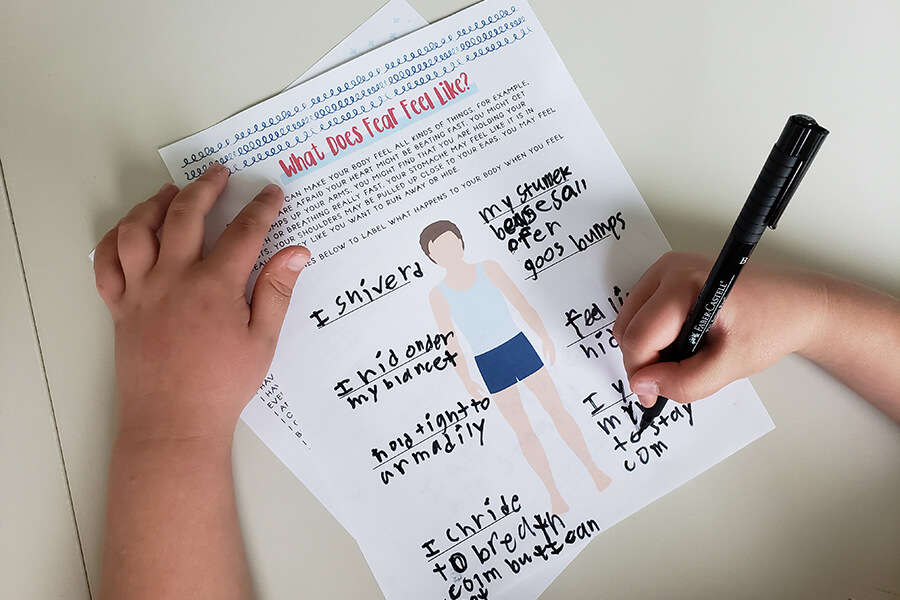
Step 4: What to do when you start having what if thoughts
Once your child becomes aware of the process of what if thoughts taking over their brain and gets a grasp on what their body’s reactions are to fear they will be able to move on to learn what to do when they have that first what if thought.
It is important to know that different kids will be drawn to different calming techniques. Because of this, you may have to try different ideas and practice them with your child to find what works best for him or her. Here are some different coping skills that can work for kids.
Coping Skills Activities that can help you feel braver and less afraid
There are many different types of coping skills. Choosing which skill(s) to teach your children can really depend on their personality and on the situation that you are trying to manage.
As an example, my oldest son is a very active kid. He does best with learning and using skills that allow him to burn off excess energy and funnel his attention towards physical expressions to work through emotions.
On the other hand, my youngest son does really well with creative and artistic coping skills that allow him to use his imagination and come up with creative solutions to his problems.
Deep Breathing Exercises
Deep Breathing can be an easy and very effective skill to manage fear. Taking a deep breath helps to calm down the body and focus the mind. Because deep breathing is an easy skill to teach, I often recommend this as a great introduction to coping skills for kids.
You can check out this article here for some different deep breathing techniques for kids. There are instructions and tips for teaching and practicing deep breathing.
Physical Exercises
Physical exercises are another great coping skill. Two popular categories of exercises include ones to burn off excess energy and ones to help the blood flow return to the brain.
Exercises for burning off excess energy work really well for kids who struggle with behavior around feeling frustrated and angry. They can help children funnel some of their frustration into a positive outlet rather than into acting out with negative behaviors. Examples of these types of exercise would include: jumping on a trampoline, doing jumping jacks, having a dance party, running in place, or doing push-ups.
The other important category of physical exercise focuses more on restoring blood flow to the brain. These are important because when big emotions start to take over, the blood actually rushes out of our brains and makes it harder to make logical and reasonable choices. Helping the body calm down and returning the blood flow to the brain helps bring back rational thought.
Examples of blood flow exercises include the downward dog yoga pose, laying upside down off a couch, or doing a full-body muscle relaxation/body scan.
Distraction Techniques
Distraction can be another really helpful coping skill. You hear a lot about this these days when people talk about staying off of social media or turning off the news.
For kids, I find that scavenger hunts and laughter tends to work the best. A great scavenger hunt to use for distraction is the ABC scavenger hunt. (Find something that starts with A, find something that starts with B, etc.)
Laughter and playfulness are another great distraction technique that can really disrupt negative thought patterns or behaviors. I wrote this article about using playfulness to stop a temper tantrum and it is a great resource for finding ideas to bring playfulness and laughter in as a coping skill.
Using the 5 Senses
Using our 5 senses can be very grounding and really help kids step out of their scary thoughts. My favorite coping skill that utilizes the 5 senses is a 5 senses scavenger hunt. You can download this free mini coping skills card deck that has instructions or check out the full printable coping skills card deck here.
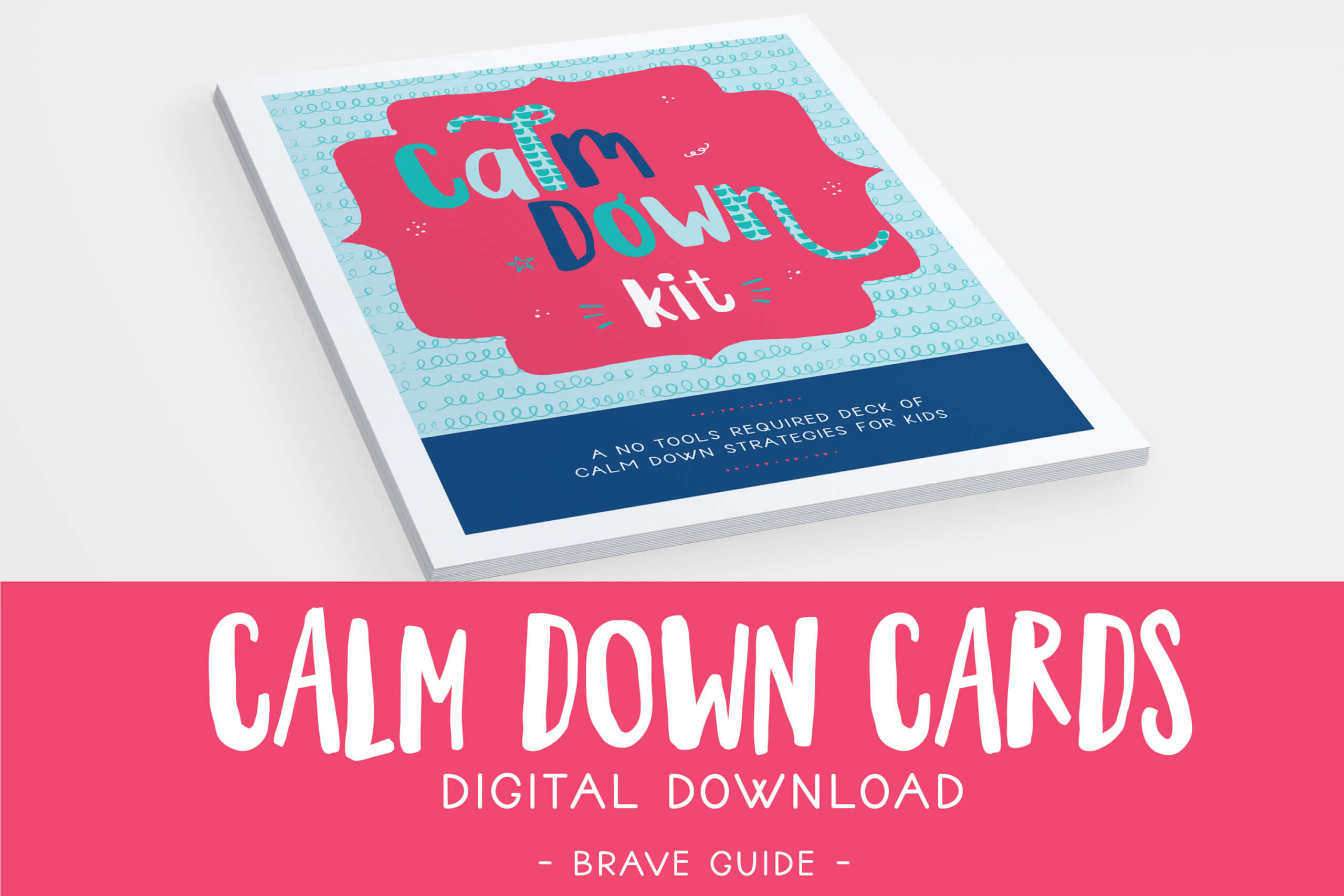
Another great exercise that brings in the 5 senses is to imagine a favorite place and then think about what you are seeing, what you are hearing, what you can feel, what it smells like, and what tastes you may experience there.
Helping Kids Use Coping Skills
Once your child learns some coping skills, they need to practice the activities in order to have them work consistently. There are a lot of ways to help children practice coping skills. I like to incorporate the practice into our daily routines. For example. we practice deep breathing at bedtime.
Creating something that can act as a reminder can also help reinforce coping skills. I love these deep breathing posters that I hang in my son’s room to help remind him to practice his deep breathing.
I also love using a bravery shield with kids. This is a fun little project that you can do with your kids.
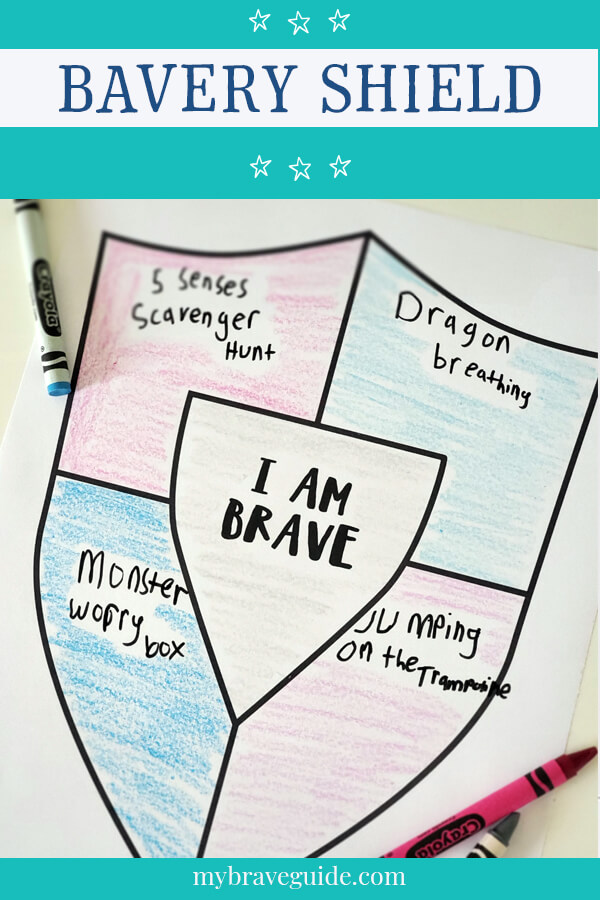
To start, download the bravery shield template here.
Then, have your kids write in different skills that they can use to help them feel brave (coping skills). They can come up with 1 skill for each section or write multiple skills in each section.
Then, have your children color and decorate their shields as much they would like.
I think these are a great thing to hang up in their bedrooms, on their bathroom mirror, or anywhere else where they will see it frequently and be reminded of the skills they can use anytime they need help feeling braver.
A fun project for kids to manage their worries and fears
Here is another fun idea for incorporating coping skills in a creative way. This is one of my all-time favorite activities for kids who are afraid and struggling with fear issues.
Worry Monsters
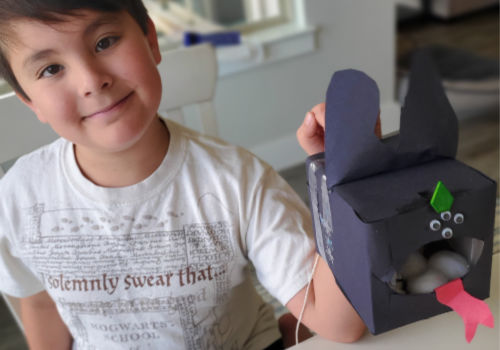
Supplies
1 small box (a tissue box or shoebox works well.)
Paper to cover the box (I’ve used wrapping paper or construction paper in the past.)
Decorations (crayons, markers, stickers, googly eyes, or whatever your child would like.)
Instructions:
- Cover the box with paper.
- Have an adult help cut out a hole for the mouth
- Decorate the box to look like a monster
- Cut up a sheet of paper into smaller strips.
- Write fears and worries on the strips of paper and feed them to the worry monster.
The concept of the worry monster is that he eats your worries so that you don’t have to be afraid of them anymore.
Kids can write down any what if thoughts, things they are afraid of, or worries that they have. Have your children place these worries into the monster’s mouth and leave them there to be “eaten” and taken care of.
Helping Kids Deal with Their Fears
In conclusion, being scared is a normal, natural emotion. If your child is struggling with fear overtaking their thoughts, there are four steps you can take to help them manage fear.
Start by helping your child understand their “What if” thoughts. Next, help your child understand what happens in their minds when those what if thoughts get away from them.
Creating a plan to deal with worry or fear thoughts when they are first noticed can help alleviate a lot of the issues of fear for kids. Using coping skills will help kids manage their thoughts anytime they feel scared.
Other Article for Kids Who Struggle with Fear
Dealing with Nighttime Fears When You’ve Tried Everything
